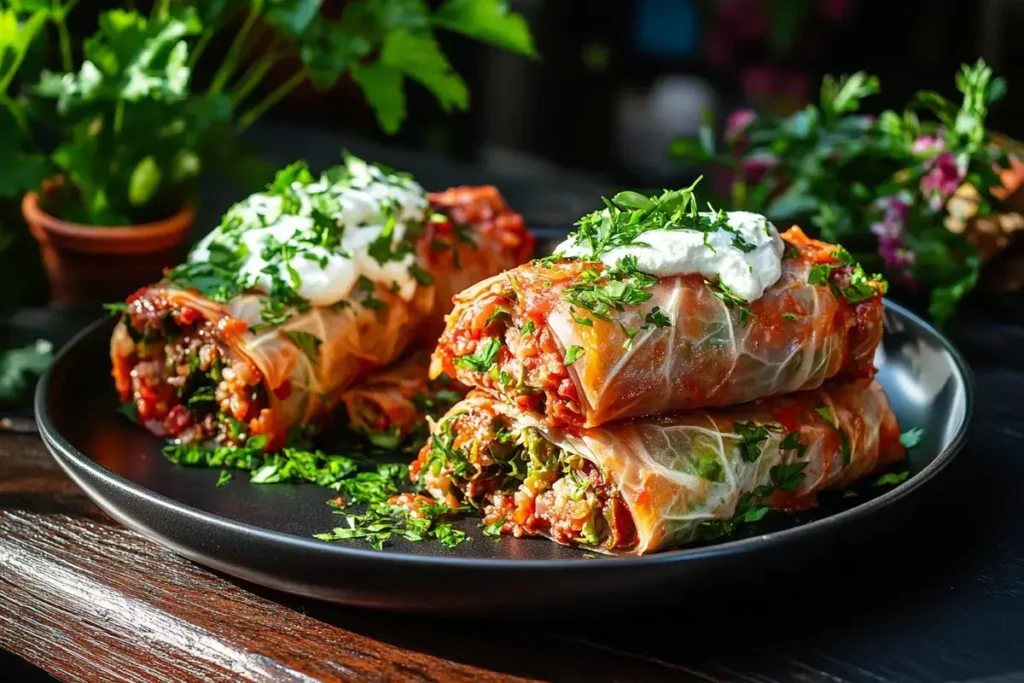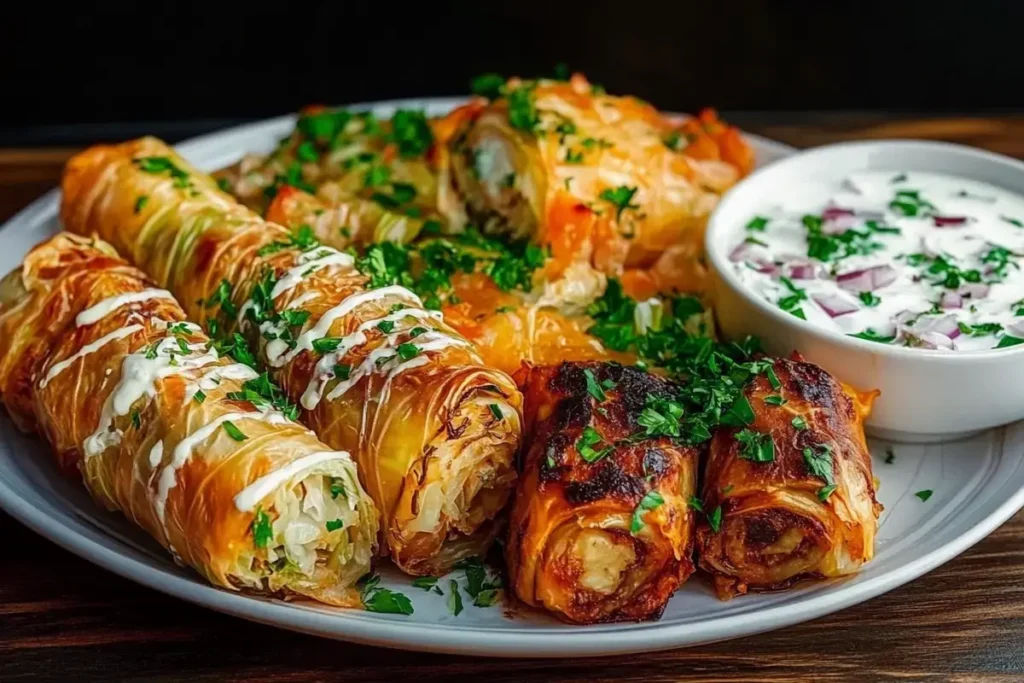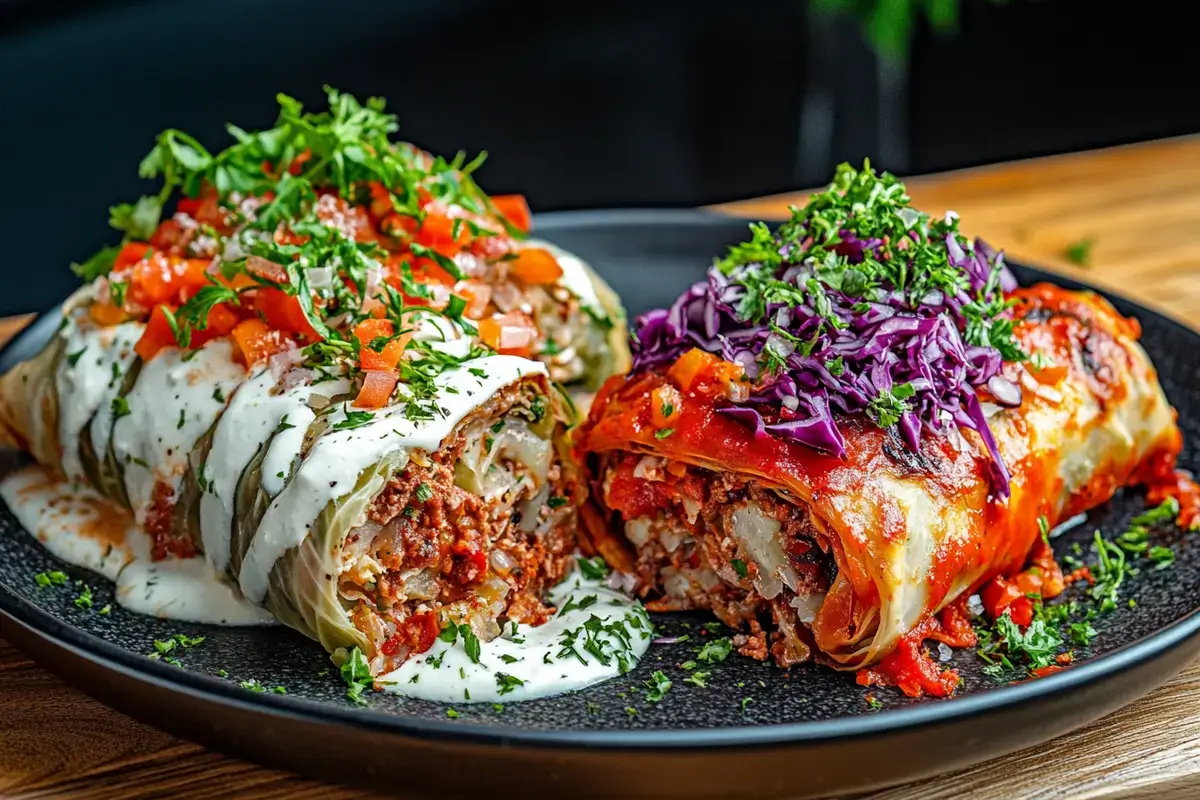Hey everyone, Jessika here from Boldy Recipes! Growing up with Eastern European neighbors and later traveling through Poland and Ukraine for culinary research, I’ve had the privilege of tasting authentic cabbage rolls from both traditions. While they look similar on the surface, Polish and Ukrainian cabbage rolls have distinct differences in filling, sauce, and preparation. Let me break down what sets these comfort food classics apart.
The Names: Gołąbki vs Holubtsi
Polish Cabbage Rolls: Called gołąbki (pronounced go-WOMP-kee), which translates to “little pigeons” , referring to their plump, rounded shape.
Ukrainian Cabbage Rolls: Known as holubtsi (pronounced ho-LOOP-tsee), also meaning “little pigeons” in Ukrainian.
Despite the similar names, the recipes diverge significantly.
The Filling: Key Differences
Polish Gołąbki
Grain Base: Always uses white rice mixed with ground meat (typically pork or beef-pork blend). The rice is usually partially cooked before mixing.
Meat Ratio: Higher meat-to-rice ratio, making them heartier and meatier. Generally 60-70% meat.
Seasoning: Salt, pepper, onions, and sometimes garlic. Relatively simple and meat-forward. Marjoram is occasionally added.
Texture: The filling is denser and more compact due to higher meat content.
Ukrainian Holubtsi
Grain Variety: Traditionally uses buckwheat (kasha), though rice became common in modern versions. Some regions use millet or barley.
Meat Ratio: More grain-heavy with a lower meat ratio, around 40-50% meat. Some traditional versions are completely vegetarian with mushrooms replacing meat.
Seasoning: More herbs and aromatics , dill, parsley, garlic, and sometimes paprika. The flavor profile is brighter and more herbaceous.
Texture: Lighter, less dense filling due to higher grain content.

The Sauce: Where Flavor Diverges
This is where the biggest difference shows up in my experience.
Polish Sauce
Tomato-Based: Rich tomato sauce is standard , either plain tomato sauce or a sweet-and-sour tomato sauce with sugar and vinegar. Some recipes use tomato soup.
Consistency: Thicker, more concentrated sauce that coats the rolls.
Flavor: Tangy-sweet with prominent tomato flavor. Some versions add bacon or pork for richness.
Ukrainian Sauce
Lighter Approach: Often uses a combination of tomato and sour cream, creating a pink, creamy sauce. Some versions skip tomato entirely, using only sour cream or broth.
Consistency: Thinner, more broth-like. The rolls are often simmered rather than baked in thick sauce.
Flavor: Tangy from sour cream with fresh dill. Less sweet than Polish versions, more savory and herb-forward.
Cooking Method Differences
Polish Gołąbki: Typically baked in the oven covered in tomato sauce. The baking caramelizes the sauce edges and creates deeper, richer flavors. Some cooks brown them in a skillet first.
Ukrainian Holubtsi: Often simmered on the stovetop in a large pot with sauce or broth. This creates a softer texture throughout. Oven-baking is also common but with more liquid.
Size and Shape
Polish: Generally larger and more tightly packed. The rolls are substantial , usually 2-3 per serving.
Ukrainian: Often smaller and more numerous. The wrapping tends to be looser, and servings include 4-5 smaller rolls.
Regional and Family Variations
From my research and conversations with home cooks in both countries, I’ve learned that family recipes vary enormously within each culture.
Polish Variations: Some families add mushrooms to the filling, use different meat combinations, or make the sauce with sauerkraut instead of tomato.
Ukrainian Variations: Western Ukraine tends toward the tomato-sour cream sauce, while Eastern regions often use pure sour cream. Vegetarian versions are more common in Ukrainian tradition.
My Professional Take
After making both versions extensively, here’s what I’ve noticed: Polish gołąbki are heartier, meatier, and sweeter with that characteristic tomato-based sauce. They’re comfort food in the most indulgent sense rich and satisfying.
Ukrainian holubtsi are lighter, more herbaceous, and grain-forward, with that distinctive sour cream tang. They feel more balanced and less heavy.
Both are absolutely delicious, but they serve slightly different purposes. Polish cabbage rolls are perfect for cold winter nights when you want something really substantial. Ukrainian versions work well year-round and feel less indulgent while still being incredibly comforting.
The Bottom Line
The main differences: Polish cabbage rolls use white rice, more meat, and thick tomato sauce. Ukrainian cabbage rolls traditionally use buckwheat, less meat, more herbs, and lighter sour cream-based sauce.
Think of it this way: if Polish gołąbki are like a hearty meatloaf wrapped in cabbage, Ukrainian holubtsi are like a pilaf wrapped in cabbage. Both are wonderful expressions of Eastern European cooking, just with different philosophies.

Frequently Asked Questions
Are Polish and Ukrainian cabbage rolls the same recipe?
No. While similar in concept, Polish gołąbki use white rice, more meat, and thick tomato sauce, while Ukrainian holubtsi traditionally use buckwheat, less meat, more herbs, and lighter sour cream-based sauce.
Which cabbage is used for both?
Both use green cabbage (savoy cabbage works too). The leaves are blanched or steamed until pliable. There’s no difference in the cabbage preparation between Polish and Ukrainian versions.
Can I use the same filling for both?
You can, but you’ll lose the authenticity. The different grain bases (rice vs buckwheat) and meat ratios create distinct textures and flavors that define each tradition.
Which one is healthier?
Ukrainian holubtsi are generally lighter with more grains, less meat, and no heavy tomato sauce. Polish gołąbki are richer and more calorie-dense. Both can be made healthier with lean meat and less sauce.

